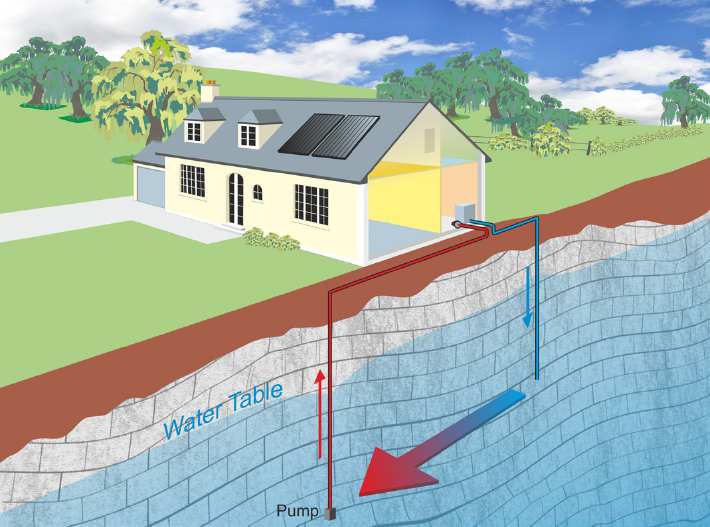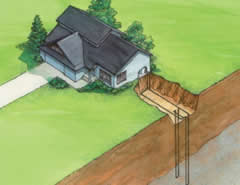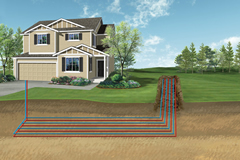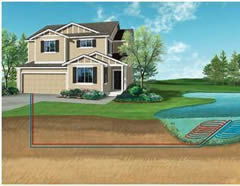A geothermal system makes use of the largest source of energy available - the ground beneath your feet.
The Ground
A geothermal system uses the energy of the sun, stored in the earth, to keep you in comfort all year round.Even in the winter, when a blanket of snow covers the ground, the earth's temperature remains approximately 10°C (50°F) at only six feet below the surface.This means that you have a steady supply of heat to keep you in comfort, even in the depths of the coldest winter.
The Loop – heat source/sink
There are 4 main types of loops . There are 3 types of closed loop Vertical, Horizontal and pond/lake loop . Closed loop systems have a series of pipes buried in the ground or submerged in a body of water . An ethanol solution is circulated through the pipes to make them highly efficient conductors of heat. In the winter, the ethanol solution in the pipes absorbs the heat from the ground and, now warmed up, the fluid is pumped back through the geothermal unit in the house. In the summer, the heat transfer process takes place in reverse. The fluid in the pipes leaves the house in a warm state, but after circulating underground, is cooled as the pipes exchange heat with the cooler earth.
The other type of loop is an open loop system . Water is pumped from a well through a geothermal heat pump and then returned to the ground through an injection or dump well . An open loop system works much like a closed loop system but unlike a closed loop system it brings fresh water and does not recycle the loop fluid . An open loop geothermal unit can be highly efficient and doesn't need elaborate piping .
 |
| Open Loop |
The Geothermal Unit
The underground loops connect to the main geothermal unit installed in your house, and is connected to your home's forced air or hydronic system. Compatible with your home's distribution system.
Forced Air
Forced air systems us an air-handler to distribute heat from the ground to the air in a home or building through a system of ductwork and vents. When air conditioning is needed, the process is reversed. Similar to the way a refrigerator operates, the geothermal heat pump removes heat so cold air moves throughout the home or building.
Radient Heating
Radiant, in-floor heating is known as the most comfortable type of heating. This heating method uses a series of pipes in the floor of a home or building to circulate warm water. This allows for heat to rise from the ground up, heating the space evenly and without drafts or ductwork noise.
The Distribution System
Heating In Winter
After the pipes have done the heat transfer, and the geothermal unit has done its work maximizing the heat value of the circulated fluid, the heat is then drawn off the heat exchanger in the unit and circulated throughout the house using the existing distribution system.
Cooling In Summer
In the summer, the process is reversed. The hot air in the house is essentially absorbed by the geothermal unit which now circulates much cooler pipe fluid. The heat is transferred first to the pipes then to the ground outside before returning, cooled, to the house.
Distribution
The geothermal unit is connected to the home's existing heating/cooling distribution system, whether it's forced air, or water-to-water in-floor radiant.
Low Maintenance
Cleaning the electrostatic filter is all that's needed to keep the system in good running order.
Quiet Operation
Pumps quietly circulate fluid through the heat exchanger. No combustion or forced-flame noise is heard. An outdoor air conditioning unit, often noisy, is not required.
Comfort
Geothermal systems eliminate indoor temperature swings and humidity changes that often occur with traditional systems. In addition, the occasional odour caused by combustion of fossil fuel will also be eliminated.
Long System Life
Geothermal units life expectancy is 20-25 years.
The Environment
Geothermal systems use a renewable resource, the earth, which is efficient and non-polluting. Replacing a fossil fuel system with geothermal immediately cuts your household energy emissions by 50%, the equivalent of taking four cars off the road. Federal and provincial governments recognize the important role that geothermal plays in reducing home energy use, and have created rebate programs to facilitate installation.



